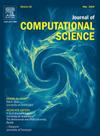具有傅里叶特征映射的深度里兹方法:一种解决微观结构变分模型的深度学习方法
IF 3.7
3区 计算机科学
Q2 COMPUTER SCIENCE, INTERDISCIPLINARY APPLICATIONS
引用次数: 0
摘要
本文提出了一种将深里兹方法(DRM)与傅立叶特征映射相结合的新方法来解决由多井、非凸能量势组成的最小化问题。由于缺乏全局最小值,这些问题对计算提出了挑战。通过对一维和二维三个基准问题的研究,我们观察到DRM存在频谱偏差病理,限制了其学习高频解的能力。为了克服这一限制,我们通过引入傅里叶特征映射来改进该方法。这种修改包括在输入层通过隐藏层和输出层之前对其应用傅里叶映射。我们的研究结果表明,傅里叶特征映射使DRM能够为一维和二维的基准问题生成高频、多尺度的解决方案,为解决复杂的非凸能量最小化问题提供了有希望的进展。本文章由计算机程序翻译,如有差异,请以英文原文为准。

Deep Ritz method with Fourier feature mapping: A deep learning approach for solving variational models of microstructure
This paper presents a novel approach that combines the Deep Ritz Method (DRM) with Fourier feature mapping to solve minimization problems comprised of multi-well, non-convex energy potentials. These problems present computational challenges as they lack a global minimum. Through an investigation of three benchmark problems in both 1D and 2D, we observe that DRM suffers from spectral bias pathology, limiting its ability to learn solutions with high frequencies. To overcome this limitation, we modify the method by introducing Fourier feature mapping. This modification involves applying a Fourier mapping to the input layer before it passes through the hidden and output layers. Our results demonstrate that Fourier feature mapping enables DRM to generate high-frequency, multiscale solutions for the benchmark problems in both 1D and 2D, offering a promising advancement in tackling complex non-convex energy minimization problems.
求助全文
通过发布文献求助,成功后即可免费获取论文全文。
去求助
来源期刊

Journal of Computational Science
COMPUTER SCIENCE, INTERDISCIPLINARY APPLICATIONS-COMPUTER SCIENCE, THEORY & METHODS
CiteScore
5.50
自引率
3.00%
发文量
227
审稿时长
41 days
期刊介绍:
Computational Science is a rapidly growing multi- and interdisciplinary field that uses advanced computing and data analysis to understand and solve complex problems. It has reached a level of predictive capability that now firmly complements the traditional pillars of experimentation and theory.
The recent advances in experimental techniques such as detectors, on-line sensor networks and high-resolution imaging techniques, have opened up new windows into physical and biological processes at many levels of detail. The resulting data explosion allows for detailed data driven modeling and simulation.
This new discipline in science combines computational thinking, modern computational methods, devices and collateral technologies to address problems far beyond the scope of traditional numerical methods.
Computational science typically unifies three distinct elements:
• Modeling, Algorithms and Simulations (e.g. numerical and non-numerical, discrete and continuous);
• Software developed to solve science (e.g., biological, physical, and social), engineering, medicine, and humanities problems;
• Computer and information science that develops and optimizes the advanced system hardware, software, networking, and data management components (e.g. problem solving environments).
 求助内容:
求助内容: 应助结果提醒方式:
应助结果提醒方式:


